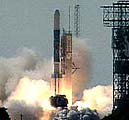| . |  |
. |
Washington, DC - Dec 30, 1997 -  Washington, DC - Dec 30, 1997 - When the history of the Space Age is
recounted, 1997 is likely to be remembered for two main events: one millions of miles away on the ancient Martian riverbeds, the other 200 klicks overhead in low Earth orbit.
Washington, DC - Dec 30, 1997 - When the history of the Space Age is
recounted, 1997 is likely to be remembered for two main events: one millions of miles away on the ancient Martian riverbeds, the other 200 klicks overhead in low Earth orbit.
But for those whose financial fortunes lie in space commerce, the year was nothing short of dazzling, with the triumphant launches of the Iridium system opening the door to a decade of satellite commerce and bold new endeavors in space transportation, set to gain strength in the year ahead.
The team drew almost as much attention as the rocket's failure itself. Industry awaiting release of the Deltas chafed at Air Force security restrictions and lack of communications as the investigation dragged on. Eventually, the rocket's strap-on GEM motors were fingered as the cause, with improved assembly and quality inspections identified as improvements needed to avoid another, similar failure. But the controversy over the team and its lengthy investigation lead the Air Force at year's end to overhaul its investigation procedures. The remaining launches of 1997 went nearly flawlessly. Since its return to flight in late summer, ten DeltaIIs have been launched during the remainder of the year, all without any incident. Orbital Sciences Corp. lofted five Pegasus XL's during the year, all successfully. Lockheed Martin's LMLV-1, renamed at midyear the Athena, sped aloft from Vandenberg with the Lewis satellite aboard, marking the rocket's comeback from a 1996 explosion and the first successful launch ever from Space Launch Complex 6.
India was also successful in 1997 with launches of their PSLV booster sending Indian remote sensing spacecraft into Earth orbits. But Brazil wasn't so lucky. Its long awaited VLS finally lifted from the Spaceport at Alcantara Brazil, only to explode in midair seconds after take-off. The setback may cause years of delay with the Brazilian rocket program. China, however, has begun to recover from its string of launch failures in the mid-90s, with a trio of successful Long March 2 and 3 variant launches returning that nation to commercial space competitionin 1997.
And there was yet one other commercial space development in 1997. On June 2nd , the first commercial news service on the Internet devoted to space news and written and edited by professional journalists began webcasting. It's name? SpaceCast. See you in 1998.
 Dulles Va - Dec. 29 1997 -
Dulles Va - Dec. 29 1997 - OrbComm Global the first provider of commercial global low-Earth orbit (LEO) satellite data and messaging communications services, today announced that its Network Control Center has established ground communication with seven of the eight low-Earth orbit (LEO) satellites launched from NASA's Wallops Island Flight Facility on December 23. Efforts to communicate with the remaining satellite are underway. The average orbit of the satellites is reported to be a near-perfect 816 by 824 kilometers. |
|
|
|
|
|
|
|
|
|
|
|
|
|
| The content herein, unless otherwise known to be public domain, are Copyright 1995-2006 - SpaceDaily.AFP and UPI Wire Stories are copyright Agence France-Presse and United Press International. ESA PortalReports are copyright European Space Agency. All NASA sourced material is public domain. Additionalcopyrights may apply in whole or part to other bona fide parties. Advertising does not imply endorsement,agreement or approval of any opinions, statements or information provided by SpaceDaily on any Web page published or hosted by SpaceDaily. Privacy Statement |